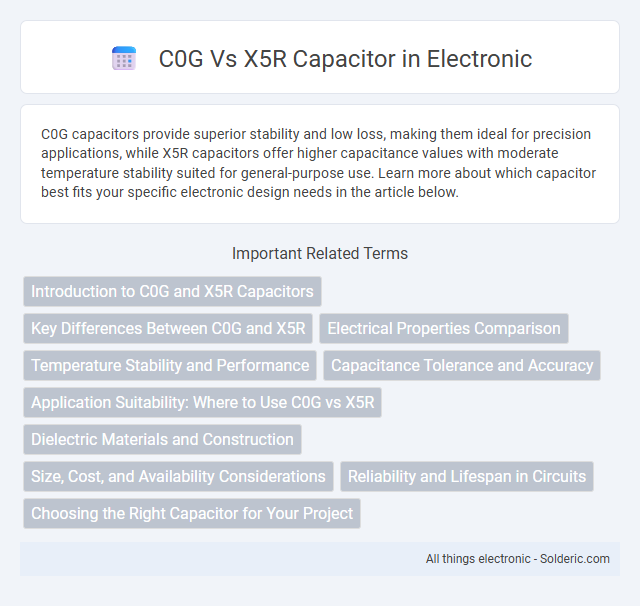C0G capacitors provide superior stability and low loss, making them ideal for precision applications, while X5R capacitors offer higher capacitance values with moderate temperature stability suited for general-purpose use. Learn more about which capacitor best fits your specific electronic design needs in the article below.
Comparison Table
| Feature | C0G Capacitor | X5R Capacitor |
|---|---|---|
| Dielectric Type | Class 1 ceramic | Class 2 ceramic |
| Temperature Stability | +-30 ppm/degC | +-15% over -55degC to 85degC |
| Capacitance Range | Typically low (pF to nF) | Higher capacitance (nF to uF) |
| Voltage Rating | Up to 100 V or higher | Typically up to 50 V |
| Dielectric Loss (DF) | Very low (~0.0001) | Moderate (~0.02) |
| Application | Precision timing, RF circuits, filters | General purpose decoupling, bypass |
| Capacitance Change with Voltage | Negligible | Significant |
| Physical Stability | Excellent | Can vary with temperature and voltage |
Introduction to C0G and X5R Capacitors
C0G and X5R capacitors are common types of ceramic capacitors used in electronic circuits, each with distinct characteristics suited for specific applications. C0G capacitors offer stable capacitance, low dielectric losses, and excellent temperature stability, making them ideal for precision timing and filtering tasks. X5R capacitors provide higher capacitance values and volumetric efficiency but exhibit greater capacitance variation with temperature, voltage, and aging, which may affect Your circuit's performance in less critical applications.
Key Differences Between C0G and X5R
C0G capacitors deliver outstanding stability and low dielectric loss with minimal capacitance change over temperature, frequency, and voltage, making them ideal for precision applications. X5R capacitors offer higher capacitance density but experience significant variation in capacitance and increased dielectric losses with temperature and voltage changes, suited for general-purpose applications. The key differences lie in C0G's Class 1 dielectric providing stable electrical properties, versus X5R's Class 2 dielectric prioritizing higher capacitance at the expense of stability.
Electrical Properties Comparison
C0G capacitors exhibit exceptional electrical stability with near-zero capacitance change over temperature, voltage, and frequency variations, making them ideal for precision applications. X5R capacitors offer higher capacitance values but experience significant capacitance variation, typically +-15% over a -55degC to +85degC temperature range, along with voltage-dependent capacitance drop. C0G types have low dielectric loss and minimal aging effects, while X5R capacitors show higher dielectric losses and noticeable capacitance decrease over time.
Temperature Stability and Performance
C0G capacitors offer excellent temperature stability with negligible capacitance change across a wide temperature range, typically +-30 ppm/degC, making them ideal for precision applications. X5R capacitors, on the other hand, exhibit higher capacitance variation, up to +-15% over their temperature range, which can impact circuit performance in sensitive environments. Your choice between C0G and X5R should consider the required stability and performance in temperature-dependent conditions.
Capacitance Tolerance and Accuracy
C0G capacitors offer exceptional capacitance tolerance and accuracy, typically within +-0.05% to +-0.1%, ensuring highly stable performance across temperature and voltage variations. In contrast, X5R capacitors exhibit a wider tolerance range, often +-10% to +-20%, with capacitance values significantly affected by temperature and applied voltage changes. Your choice between C0G and X5R should consider the precision requirements of your circuit, as C0G is ideal for applications demanding minimal variation, while X5R suits cost-sensitive designs with moderate accuracy needs.
Application Suitability: Where to Use C0G vs X5R
C0G capacitors offer exceptional stability, low dielectric absorption, and minimal temperature coefficients, making them ideal for precision applications such as RF circuits, oscillators, and timing devices where accuracy is critical. In contrast, X5R capacitors provide higher volumetric efficiency and capacitance per unit volume, suitable for general-purpose decoupling, filtering, and bulk energy storage in power supply circuits where moderate stability is acceptable. Selecting C0G or X5R depends on the trade-off between stability requirements and capacitance density in the target electronic design.
Dielectric Materials and Construction
C0G capacitors use a ceramic dielectric composed of stable materials such as titanium dioxide, offering minimal capacitance change with temperature and excellent electrical stability. X5R capacitors feature a ferroelectric ceramic dielectric that provides higher capacitance values but exhibits greater capacitance variation with temperature and voltage. Your choice depends on whether you prioritize precise, stable performance (C0G) or higher capacitance in a compact form (X5R).
Size, Cost, and Availability Considerations
C0G capacitors are typically smaller in size due to their stable dielectric properties, which allow for precise performance in compact designs, whereas X5R capacitors often demand a larger footprint to achieve higher capacitance values. When considering cost, X5R capacitors are generally more affordable because their ceramic materials and manufacturing processes are less expensive compared to the premium C0G dielectrics. Your choice may also be influenced by availability, as X5R capacitors are widely stocked and available in a broad range of capacitances, while C0G capacitors may have limited options and longer lead times depending on the specifications needed.
Reliability and Lifespan in Circuits
C0G capacitors exhibit exceptional reliability and a longer lifespan due to their stable dielectric properties and minimal capacitance change under varying temperature, voltage, and frequency conditions. In contrast, X5R capacitors, while offering higher capacitance values, experience significant capacitance drift, increased dielectric losses, and degradation over time, affecting circuit performance and reducing operational lifespan. Engineers prioritize C0G types in high-precision, long-term applications where stability and reliability are critical.
Choosing the Right Capacitor for Your Project
Selecting the right capacitor hinges on understanding C0G and X5R dielectric materials: C0G capacitors offer stable capacitance with low dielectric loss, making them ideal for precision circuits requiring minimal temperature variation. X5R capacitors provide higher capacitance values in smaller sizes but exhibit significant capacitance variation with temperature and applied voltage, suitable for decoupling and filtering applications where stability is less critical. Assessing project requirements for stability, size, and capacitance helps determine the optimal choice between C0G and X5R capacitors.
C0G vs X5R capacitor Infographic

 solderic.com
solderic.com